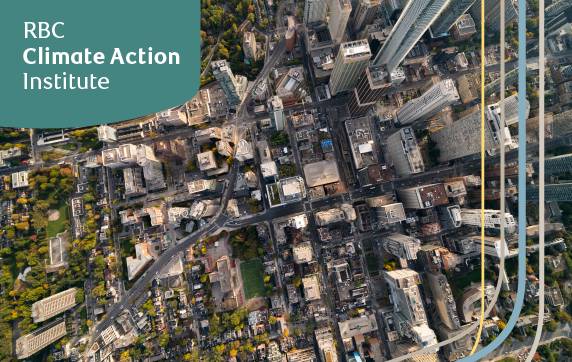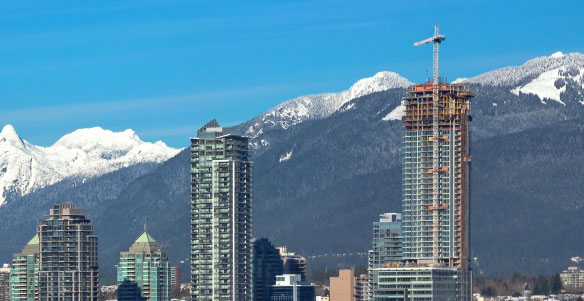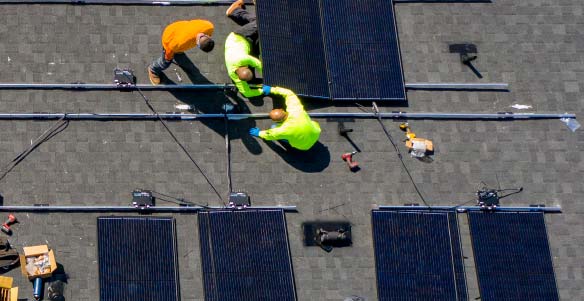Policymakers in Canada’s fastest growing cities face a triple challenge over the next decade: how to build their infrastructure for a rapidly growing population, continue lowering greenhouse gas emissions, and ensure that neither strain municipal finances.
Against this backdrop, low to zero-carbon district heating systems, and in general district energy systems, are emerging as a fiscal and climate tool that municipalities are deploying to tackle their growth, climate and fiscal trilemma. The low-carbon neighbourhood systems have the potential to lower building emissions by just over a third in Canada’s biggest cities, according to our research.
District Heating Systems – A Solution for Multiple Challenges
District heating is a large-scale approach to heating a cluster of buildings with energy produced by a central heating plant. It’s not new to Canada, though. The first central steam heating plant was established in 1878 in London, a mid-sized city in southwestern Ontario. The plant provided downtown businesses with heat, distributed through an underground network of pipes to individual buildings. The network-based neighbourhood approach to heating fell out of favour in the country around the late 1950s, as natural gas became widely available for space heating.
Canada’s ratification of the Paris Agreement in 2016—a legally binding international treaty on climate change—has compelled municipalities to explore ways to transition away from natural gas for space heating while also scaling their greenhouse gas reduction efforts. And district heating systems are increasingly emerging as their solution of choice. These new systems are designed to be low to zero carbon and take advantage of the most cost-effective and low carbon feedstock in close proximity to a system’s central heating plant. Common feedstocks include recovered heated sewer water, such as those from showers and dishwashers, heat stored up to 350-metre deep below the ground, or biomass, such as wood chips and plant waste. Heat pumps or heat exchangers, powered by electricity, are used to move heat generated at a central plant to buildings in the heating network.
The Climate Imperative
Buildings is the third largest source of emissions in the country and the single largest source of municipal emissions, accounting for an estimated 50-60% of all its emissions1.
The challenge of building physical infrastructure is that it’s locked in for up to 60 years in some cases. The strategic and political choices made today will dictate the long-term fiscal and climate health of these cities for more than half a century.
Embodied emissions, which is the carbon in building materials, is more challenging to decarbonize than operating emissions, due to the “green premium” and limited availability of low-carbon building materials.
Given this constraint, municipalities are focusing their policy efforts on reducing emissions from space heating, which account for 65% of operating emissions. A common policy lever is to mandate construction of more energy efficient buildings. A shortcoming of such policies is their failure to address a key change crucial to reaching Net Zero—to switch away from natural gas to carbon free energy sources, especially for space heating. Energy efficiency policies’ intent to lower the amount of energy consumed, and decarbonization policies’ focus on reducing emissions, has led to the emergence of another policy lever that can achieve both policy outcomes: the deployment of low or zero-carbon district heating systems.
Building upon analysis that engineering consultants RWDI undertook for the Climate Smart Building Alliance, the Climate Action Institute estimates that building sector emissions in Canada’s largest cities could conservatively be reduced by 36% annually, were 27% of all new building floor space connected to a district heating system powered by low or zero-carbon energy sources2. That’s four and a half times greater than the current rate of decarbonization for the electricity sector, which has already experienced the fastest decline in emissions in Canada over the past several years3.
The Fiscal Imperative
Municipal infrastructure is costly to repair and maintain. The Federation of Canadian Municipalities’ latest report estimates that local governments across Canada have a $170 billion infrastructure repair backlog, an amount that is 217 times greater than Vancouver’s 2024 capital budget4.
Property taxes, originally conceived to fund community-wide infrastructure and services, such as fire protection, roads and parks, have evolved since the 1990s to fund infrastructure that only benefits a subset of the community’s households and businesses. The trend towards socializing the costs of private benefits, combined with limited revenue raising tools, legislative requirements for balanced budgets and limits on public debt issuances have all contributed to the massive infrastructure repair backlog.
The on-going structural challenges of municipal finance, and the high capital and operating costs of greening infrastructure has municipalities on the hunt for innovative fiscal tools that can shift costs from taxpayers to ratepayers. Privatization of utility costs is emerging as a potential solution. To date, the greatest adoption of this practice is the provision of low or zero-carbon thermal energy through the creation of a district energy system.
District thermal systems, a subset of DES, provide a hat-trick of benefits for municipalities. They facilitate the creation of low to zero-carbon thermal grids, they are crucial to increasing the pace of building decarbonization, and they don’t impose a burden on municipal finances. For municipally owned systems, district thermal systems serve as a new and significant revenue stream, which can be tapped into without new legislative authority5. Revenues are generated, at the building level, from a variable charge for thermal energy consumption and a fixed charge for the amount of system capacity required to provide heat to a building.
The enabling factors for the triple benefit are a business model predicated on full cost recovery, spread over a 30-year time horizon, and aided by regulatory requirements that all buildings must have a utility connection for thermal heating6. System owners take on the initial capital risk of designing and building a system. These capital costs, in addition to operating costs, are directly passed onto ratepayers once a system enters operations. System owners are compensated for the asymmetric risks at project onset, through 30 years of steady, predictable and recession-proof streams of revenue.
The Path To Greater and Faster Adoption
Market forces have primarily driven the deployment of district heating systems to date. Five supply and demand policies, if enacted through Official and Secondary Plans, by-laws and climate strategic plans can speed up their scale and adoption.
-
 Policy Support 1: Introduce Mandatory Connection By-laws
Policy Support 1: Introduce Mandatory Connection By-lawsThe current crop of new low carbon district heating systems is driven by real estate developers looking to decarbonize their master planned greenfield projects. Devoid of infrastructure connections and utility connections, such developments are fertile ground for the deployment of district heating systems. The blank canvas gives real estate developers complete freedom to choose and build the most cost effective and climate friendly energy sources for their development, unlike other types of developments.
District heating systems have also been deployed for brownfield developments, such as the redevelopment of the False Creek Neighbourhood in Vancouver. On brownfield sites, however, district heating systems often must compete with natural gas or other pre-existing thermal energy infrastructure. By-laws requiring real estate developers to connect their buildings to existing district heating systems can help in scaling demand, by removing developer discretion of the type of thermal energy connection to provide for their developments. Mandatory connection by-laws are common in Vancouver and the lower mainland of British Columbia.
-
 Policy Support 2: Promote Integration of District Heating in New Projects
Policy Support 2: Promote Integration of District Heating in New ProjectsDistrict heating systems are most cost effective when deployed in high density, mixed-use developments where infrastructure costs can be spread across a greater number of buildings. The mixed-use characteristic of a development is important as it contributes to variable heating demand throughout the day, given the different demand patterns between residential and commercial buildings. This variability in peak demand is important for minimizing system build and operating costs. A smaller system can be built to handle total and peak demand, and peak operating costs are lowered as consumption is spread out.
Introducing policies in Official and Secondary Plans that lay out the circumstances of when district energy systems should be considered will aid in their adoption and economic viability. The City of Toronto’s Official Plan has several policies requiring developers to consider the incorporation of district energy systems when planning new neighbourhoods or when developing in areas zoned for mixed-use projects.
-
 Policy Support 3: Recognize and Reward Adoption
Policy Support 3: Recognize and Reward AdoptionAn increasing number of municipalities have adopted Net Zero strategies and emissions reduction goals as part of their target-setting framework or building design and performance requirements, such as the City of Toronto’s Green Standard. These frameworks recognize the environmental benefits of low carbon district energy systems, including district heating systems. Municipalities can reward developers for their pursuit of low-carbon systems by refunding a portion of development charges and/or fast-tracking review of their applications.
-
 Policy Support 4: Create a Strategic Energy Plan
Policy Support 4: Create a Strategic Energy PlanMunicipal-wide energy plans, such as those adopted by the cities of Guelph and Edmonton, are another emission-reduction tools municipalities have adopted. Identifying where district energy systems will be built in an energy plan can aid in their adoption. They can be used to attract developers interested in incorporating ready-made, turnkey district energy systems in their projects. That’s the strategy the City of Guelph employed when it developed its district energy strategic plan in 2014. The plan identified 10 nodes in Guelph where district energy systems would be built by the city and the types of development targeted for each node.
-
 Policy Support 5: Encourage Development of District Energy-Ready Buildings
Policy Support 5: Encourage Development of District Energy-Ready BuildingsRequiring real estate developers to construct “district energy-ready” buildings to spur future demand has emerged as another proactive policy lever. Under these policies, developers construct their buildings with the equipment necessary for future connection to a planned district energy system.
Related Reading
For more, go to rbc.com/climate.

Download the Report
Contributors:
Lead author: Myha Truong-Regan, Head of Climate Research, RBC Climate Action Institute
Yadullah Hussain, Managing Editor, RBC Climate Action Institute
Shiplu Talukder, Digital Publishing Specialist
Caprice Biasoni, Graphic Design Specialist
- Buildings generated 89MT of emission in 2022.
- Estimate based on the following DES connectivity ratios by building typology and floor space, for new construction occupied between 2024 to 2030: 50% commercial and institutional; 25% multi-residential; 10% single detached and attached homes. Annual savings starting in 2030.
- The average annual rate of emissions reduction for the electricity sector between 2020 to 2022 was 8%.
- Making Canada’s Growth a Success: The Case for a Municipal Growth Framework.
- Depending on system size and heating demand, a district heating system can generate profits equivalent to 15% of a municipality’s property tax revenue.
- All builders are required to provide utilities to their buildings. In the absence of regulation and ESG related emission reduction targets, builders have discretion over whether heating will be powered by electricity or natural gas. District energy systems, given their scale, can enable the use of wasted forms of heat, which is not economically viable at a building level.
This article is intended as general information only and is not to be relied upon as constituting legal, financial or other professional advice. The reader is solely liable for any use of the information contained in this document and Royal Bank of Canada (“RBC”) nor any of its affiliates nor any of their respective directors, officers, employees or agents shall be held responsible for any direct or indirect damages arising from the use of this document by the reader. A professional advisor should be consulted regarding your specific situation. Information presented is believed to be factual and up-to-date but we do not guarantee its accuracy and it should not be regarded as a complete analysis of the subjects discussed. All expressions of opinion reflect the judgment of the authors as of the date of publication and are subject to change. No endorsement of any third parties or their advice, opinions, information, products or services is expressly given or implied by Royal Bank of Canada or any of its affiliates. This document may contain forward-looking statements within the meaning of certain securities laws, which are subject to RBC’s caution regarding forward- looking statements. ESG (including climate) metrics, data and other information contained on this website are or may be based on assumptions, estimates and judgements. For cautionary statements relating to the information on this website, refer to the “Caution regarding forward-looking statements” and the “Important notice regarding this document” sections in our latest climate report or sustainability report, available at: https://www.rbc.com/community-social- impact/reporting-performance/index.html. Except as required by law, none of RBC nor any of its affiliates undertake to update any information in this document.





